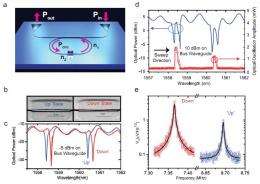October 25, 2011 report
Engineers at Yale develop new type of mechanical memory

(PhysOrg.com) -- Research engineers at Yale University have succeeded in building a mechanical memory switch that is controlled and then read by lasers. In their paper published in Nature Nanotechnology, the team, led by professor Hong X. Tang, describe how they were able to use a laser to excite a small strand of solid silicon such that its bending properties that hold steady after the laser is turned off can be used as a memory device.
To create the new memory switch, the team began with an ordinary silicon-on-insulator wafer which they fashioned into an oval waveguide to serve as an optical cavity. They then shaved away some of the wafer beneath the waveguide to create a sort of a tiny bridge made of silicon over the cavity. But because of the pressure from both ends introduced by the process that applied the silicon to the wafer originally, the bridge or strip of material buckled upwards slightly, like a toothpick squeezed slightly between the fingers. They then fired a laser into the cavity below the wave guide which caused the silicon strip to oscillate - buckling down, then back up, and so on as long as the laser was applied. When the laser was turned off, the silicon strip became stranded in either the buckled up or buckled down state, the essence of a switch (1 for up 0 for down).
Unfortunately, at this point, the up or down state could not be accurately predicted, thus, it wouldn’t be useful for much of anything. To make the switch come to rest in a predetermined up or down state, the researchers applied a laser with a lower frequency that dampened the effects of the oscillations to the point where its stopping point could be controlled by modifying the frequency applied.
Reading the up buckled or down buckled state is done by shining a low energy laser (low enough so it won’t cause the strip to change positions) into the cavity and measuring its refractive index.
The end result is a switch that can be controlled at room temperature and that will hold its position without the need for any electricity at all. The only real downside to it thus far, is that it takes far more energy to make the switch move than does conventional non-mechanical memory switches, which would make a device using it much more expensive to run. Still, Tang suggests the switch could be used in devices that don’t need to switch very often, such as an optical router, or where electromagnetic interference causes problems for devices with conventional memory.
It also seems conceivable that such a switch might one day become more commercially viable if a way could be found to reduce the power needed to create the oscillations, which could mean computers, phones, etc. that could hold onto their memory indefinitely without the need for batteries or current.
More information: Dynamic manipulation of nanomechanical resonators in the high-amplitude regime and non-volatile mechanical memory operation, Nature Nanotechnology (2011) doi:10.1038/nnano.2011.180
Preprint is available: arxiv.org/abs/1109.4681
Abstract
The ability to control mechanical motion with optical forces has made it possible to cool mechanical resonators to their quantum ground states. The same techniques can also be used to amplify rather than reduce the mechanical motion of such systems. Here, we study nanomechanical resonators that are slightly buckled and therefore have two stable configurations, denoted ‘buckled up’ and ‘buckled down’, when they are at rest. The motion of these resonators can be described by a double-well potential with a large central energy barrier between the two stable configurations. We demonstrate the high-amplitude operation of a buckled resonator coupled to an optical cavity by using a highly efficient process to generate enough phonons in the resonator to overcome the energy barrier in the double-well potential. This allows us to observe the first evidence for nanomechanical slow-down and a zero-frequency singularity predicted by theorists. We also demonstrate a non-volatile mechanical memory element in which bits are written and reset by using optomechanical backaction to direct the relaxation of a resonator in the high-amplitude regime to a specific stable configuration.
© 2011 PhysOrg.com




















